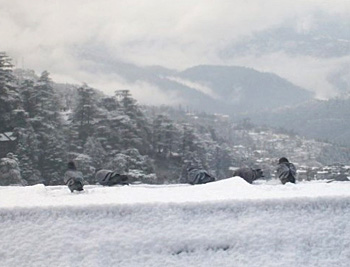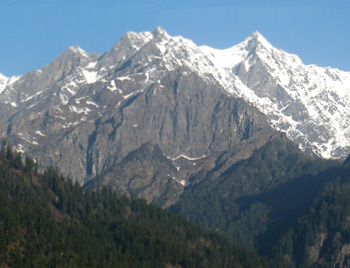 Tourism in Kullu District offers plenty of sightseeing options. Kullu District offers many attractions to the tourists. It has rich art and cultural heritage, lush green deep meadows, dazzling rivers, white capped snowy peaks and high mountains. The district has incomparable Beas River and its sub-valleys which are full of natural charm and grandeur. Though, Kullu does not have the rich historical archaeological or epigraphically antiquities like Chamba but still has some ancient remains antiquities like Nirmand and Hat at Bajaura. Not only the district is famous for its scenic beauty but also as a paradise for the trekkers and mountaineers. Major places of tourist interest in Kullu District are as follows -
Tourism in Kullu District offers plenty of sightseeing options. Kullu District offers many attractions to the tourists. It has rich art and cultural heritage, lush green deep meadows, dazzling rivers, white capped snowy peaks and high mountains. The district has incomparable Beas River and its sub-valleys which are full of natural charm and grandeur. Though, Kullu does not have the rich historical archaeological or epigraphically antiquities like Chamba but still has some ancient remains antiquities like Nirmand and Hat at Bajaura. Not only the district is famous for its scenic beauty but also as a paradise for the trekkers and mountaineers. Major places of tourist interest in Kullu District are as follows -
Kullu: Kullu town has made its name on the international tourist map for its famous Dussehra festival.
Manali: Situated near the end of valley, Manali is one of the most attractive tourist spots of Kullu District. Manali is described with beautiful streams and birdsongs, forests and orchards and amazing snow-capped mountains. Manali is the real starting point of an ancient trade route which crosses the Rohtang and Baralacha passes, and runs via Lahul and Ladakh to Kashmir while divergent road connects it with Spiti. There is an interesting legend about Manali which goes to say that Manu, the author of `Manu Samhita`, established his abode here. The temple dedicated to Manu still exists in Manali village.
 Naggar: Naggar, on the left bank of Beas River and about 300 metres above the river, is delightfully situated on a wooden slope and commands extensive views, especially of the north and west of the valley. It is 27 kms from Kullu. There is a bridge across the Beas River connecting Naggar and Patli Kulh. Naggar was founded by Visudh Pal and continued as the headquarters of the state until the capital was transferred to Kullu (Sultanpur) by Raja Jagat Singh. A massive castle belonging to the Rajas of Kullu still exists here. There is a temple of Lord Shiva, which is considered as a charming example of the architecture and carving. It is presumed that the temple which is a protected monument is eight hundred years old. Further, there are several other temples dedicated to Lord Vishnu, Lord Krishna and Pagoda shaped temple of Tripura Sundri Devi.
Naggar: Naggar, on the left bank of Beas River and about 300 metres above the river, is delightfully situated on a wooden slope and commands extensive views, especially of the north and west of the valley. It is 27 kms from Kullu. There is a bridge across the Beas River connecting Naggar and Patli Kulh. Naggar was founded by Visudh Pal and continued as the headquarters of the state until the capital was transferred to Kullu (Sultanpur) by Raja Jagat Singh. A massive castle belonging to the Rajas of Kullu still exists here. There is a temple of Lord Shiva, which is considered as a charming example of the architecture and carving. It is presumed that the temple which is a protected monument is eight hundred years old. Further, there are several other temples dedicated to Lord Vishnu, Lord Krishna and Pagoda shaped temple of Tripura Sundri Devi.
Rohtang Pass: Numerous mountain passes lead in and out of Kullu, but one of the most popular with trekking facilities is the Rohtang Pass, about 3,978 metres above sea level. It is easily the most convenient route from Manali and throughout the whole distance provides a charming view of the nature. The length of the pass is about 1 km and has served as the route for many centuries for trade with Lahul, Ladakh and to far away countries in Central Asia. To the left of Rohtang Pass there is the little lake of `Sar Kund` that is also called as Dashair.
Jagatsukh: It lies on the left bank of the Beas and the road from Naggar to Manali runs through the village. It is about twelve km from Naggar and six km from Manali. In Jagatsukh some ancient temples are still in existence. The most important being the Jagatsukh Shiva Temple. It has a very chaste sculptured decoration. The temple of Gayatri Devi is also located near this temple.
 Arjun Gufa: This cave is located at around five kms from Manali. According to a legend, Arjuna under the advice of a Vyasa rishi practiced austerities in a cave in order to get the powerful `Pashupata Astra` from Indra.
Arjun Gufa: This cave is located at around five kms from Manali. According to a legend, Arjuna under the advice of a Vyasa rishi practiced austerities in a cave in order to get the powerful `Pashupata Astra` from Indra.
Nehru Kund: It is a spring of clear cold water and is about 6 kms from Manali on Manali-Keylong road.
Solang Valley: It is a splendid valley between Manali and Kothi and offers the views of glaciers and snow caped mountains and peaks. The nearest glacier from Manali is in this valley. It is about 13 kms from Manali.
Manikaran: Nestling among, sylvan surrounding in Parbati valley, Manikaran is famous for its hot springs. Manikaran, at an altitude of 1,829 metres and 40 kms from Kullu, has the finest hot water springs. According to an ancient legend, Manikaran is also connected with Lord Shiva and his divine consort Parvati.
Gurudwara Shri Narayan Hari (Manikaran): Saint Shri Narayan Hari came to Kullu in 1940 from his native place Kamalpur (Pakistan) and settled in Manikaran. Initially there was nothing except two hot water springs in this place. He worked on the Gurudwara building and the 50 years long service bore fruit in the shape of present Gurudwara. There is an artificial cave near the Gurudwara built by the saint where he used to meditate for 40 days or so in a year.
Dhar Deo Dhank Cave: This cave is 3 km from Nirmand towards south. The cave is quite deep and about 6 feet in height. There is a Shivalinga inside the cave. Local people consider it as a very sacred place.
These places are worth visiting and they offer an enriching and tranquil tourism experience to the visitors.






